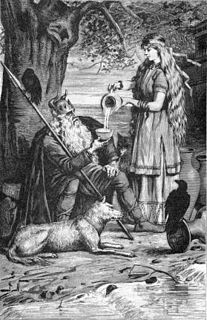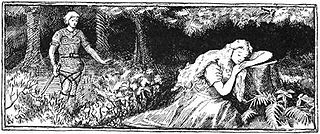
In Norse mythology, Rán is a goddess and a personification of the sea. Rán and her husband Ægir, a jötunn who also personifies the sea, have nine daughters, who personify waves. The goddess is frequently associated with a net, which she uses to capture sea-goers. According to the prose introduction to a poem in the Poetic Edda and in Völsunga saga, Rán once loaned her net to the god Loki.

In Germanic mythology, Fulla or Volla is a goddess. In Norse mythology, Fulla is described as wearing a golden band and as tending to the ashen box and the footwear owned by the goddess Frigg, and, in addition, Frigg confides in Fulla her secrets. Fulla is attested in the Poetic Edda, compiled in the 13th century from earlier traditional sources; the Prose Edda, written in the 13th century by Snorri Sturluson; and in skaldic poetry. Volla is attested in the "Horse Cure" Merseburg Incantation, recorded anonymously in the 10th century in Old High German, in which she assists in healing the wounded foal of Phol and is referred to as Frigg's sister. Scholars have proposed theories about the implications of the goddess.

In Norse mythology, Gná is a goddess who runs errands in other worlds for the goddess Frigg and rides the flying, sea-treading horse Hófvarpnir. Gná and Hófvarpnir are attested in the Prose Edda, written in the 13th century by Snorri Sturluson. Scholarly theories have been proposed about Gná as a "goddess of fullness" and as potentially cognate to Fama from Roman mythology. Hófvarpnir and the eight-legged steed Sleipnir have been cited examples of transcendent horses in Norse mythology.

In Norse mythology, Eir is a goddess or valkyrie associated with medical skill. Eir is attested in the Poetic Edda, compiled in the 13th century from earlier traditional sources; the Prose Edda, written in the 13th century by Snorri Sturluson; and in skaldic poetry, including a runic inscription from Bergen, Norway from around 1300. Scholars have theorized about whether these three sources refer to the same figure, and debate whether Eir may have been originally a healing goddess or a valkyrie. In addition, Eir has been theorized as a form of the goddess Frigg and has been compared to the Greek goddess Hygieia.

In Norse mythology, Snotra is a goddess associated with wisdom. Snotra is solely attested in the Prose Edda, written in the 13th century by Snorri Sturluson. Scholars have proposed theories about the implications of the goddess.
In Norse mythology, Vár or Vór is a goddess associated with oaths and agreements. Vár is attested in the Poetic Edda, compiled in the 13th century from earlier traditional sources; the Prose Edda, written in the 13th century by Snorri Sturluson; and kennings found in skaldic poetry and a runic inscription. Scholars have proposed theories about the implications of the goddess.

In Norse mythology, the Nine Mothers of Heimdallr are nine sisters who gave birth to the god Heimdallr. The Nine Mothers of Heimdallr are attested in the Prose Edda, written in the 13th century by Snorri Sturluson; in the poetry of skalds; and possibly also in a poem in the Poetic Edda, a book of poetry compiled in the 13th century from earlier traditional material. Scholars have debated what being "born of nine mothers" implies and have sought to connect the notion to other European folk motifs. Scholars have theorized that Heimdallr's Nine Mothers may be identical to the Nine Daughters of Ægir and Rán, who personify waves. In turn, Heimdallr would be born of the sea.
In Norse mythology, Naglfari is the father of Auðr by the personified night, Nótt. Naglfar is attested in a single mention in the Prose Edda book Gylfaginning, where he is described as one of a series of three husbands of Nótt, and that the couple produced a son, Auðr. No additional information is provided about Naglfari.
In Norse mythology, Sessrúmnir is both the goddess Freyja's hall located in Fólkvangr, a field where Freyja receives half of those who die in battle, and also the name of a ship. Both the hall and the ship are attested in the Prose Edda, written in the 13th century by Snorri Sturluson. Scholarly theories have been proposed regarding a potential relation between the hall and the ship.
In Norse mythology, Hoddmímis holt is a location where Líf and Lífþrasir are foretold to survive the long winters of Fimbulvetr. Hoddmímis holt is attested in the Poetic Edda, compiled in the 13th century from earlier traditional sources, and the Prose Edda, written in the 13th century by Snorri Sturluson. Scholarly theories have been proposed about the location and its potential connection to the world tree Yggdrasil and folktales recorded from Germanic Europe.
In Norse mythology, Lofn "the comforter, the mild," or "loving" is a goddess. Lofn is attested in the Prose Edda, written in the 13th century by Snorri Sturluson and in kennings found in skaldic poetry. In the Prose Edda, Lofn is described as gentle in manner and as an arranger of marriages, even when they have been forbidden. Scholars have proposed theories about the implications of the goddess.
In Norse mythology, Syn is a goddess associated with defensive refusal. Syn is attested in the Prose Edda, written in the 13th century by Snorri Sturluson; and in kennings employed in skaldic poetry. Scholars have proposed theories about the implications of the goddess.

In Norse mythology, Óðr or Óð, sometimes anglicized as Odr or Od, is a figure associated with the major goddess Freyja. The Prose Edda and Heimskringla, written in the 13th century by Snorri Sturluson, both describe Óðr as Freyja's husband and father of her daughter Hnoss. Heimskringla adds that the couple produced another daughter, Gersemi. A number of theories have been proposed about Óðr, generally that he is somehow a hypostasis of the deity Odin due to their similarities.
In Norse mythology, svartálfar, also called myrkálfar, are beings who dwell in Svartalfheim. Both the svartálfar and Svartálfaheimr are primarily attested in the Prose Edda, written in the 13th century by Snorri Sturluson. Scholars have noted that the svartálfar appear to be synonymous with the dwarfs and potentially also the dökkálfar. As dwarfs, the home of the svartálfar could possibly be another description for Niðavellir.
In Norse mythology, Sjöfn is a goddess associated with love. Sjöfn is attested in the Prose Edda, written in the 13th century by Snorri Sturluson; and in three kennings employed in skaldic poetry. Scholars have proposed theories about the implications of the goddess.
In Norse mythology, Auðr is the son of the personified night, Nótt, fathered by Naglfari, and uncle of Thor. Auðr is attested in the Prose Edda, written in the 13th century by Snorri Sturluson, and in the poetry of skalds.

In Norse mythology, the goddess Rán and the jötunn Ægir both personify the sea, and together they have nine daughters who personify waves. Each daughter's name reflects poetic terms for waves. The sisters are attested in the Poetic Edda, compiled in the 13th century from earlier traditional sources; the Prose Edda, written in the 13th century by Snorri Sturluson; and in the poetry of skalds. Scholars have theorized that these daughters may be the same figures as the nine mothers of the god Heimdallr.
In Norse mythology, Amsvartnir is a lake. Amsvartnir contains the island Lyngvi, where the gods bound the wolf Fenrir. The lake is solely attested in the Prose Edda book Gylfaginning, written in the 13th century by Snorri Sturluson. In the book, the enthroned figure of High tells Gangleri that the gods and Fenrir fared across Amsvartnir to get to Lyngvi, and there bound Fenrir.

In Norse mythology, Sága is a goddess associated with the wisdom Sökkvabekkr. At Sökkvabekkr, Sága and the god Odin merrily drink as cool waves flow. Both Sága and Sökkvabekkr are attested in the Poetic Edda, compiled in the 13th century from earlier traditional sources, and in the Prose Edda, written in the 13th century by Snorri Sturluson. Scholars have proposed theories about the implications of the goddess and her associated location, including that the location may be connected to the goddess Frigg's fen residence Fensalir and that Sága may be another name for Frigg.
















